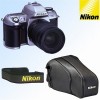Nikon F80QD User Manual - Page 13
Set Metering System and Exposure Mode
 |
UPC - 718122227020
View all Nikon F80QD manuals
Add to My Manuals
Save this manual to your list of manuals |
Page 13 highlights
Set Metering System and Exposure Mode 5 Set metering system to " (Matrix Metering) and exposure mode to ¡ (Auto-Multi Progam). 5.1 Set the metering system selector to " (Matrix Metering). • Matrix Metering indication q appears in the viewfinder. • The frame is divided into 10 segments in Matrix Metering, and data from each segment is used to determine correct exposure. Use of a D- or Gtype Nikkor lens automatically activates 3D Matrix Metering (page 48), which accounts for scene brightness and contrast, as well as subject distance (Distance Information) in order to determine exposure accurately. 5.2 Set the exposure mode select dial to ¡ (Auto-Multi Progam). • When the shutter release button is lightly pressed, shutter speed and aperture appear in the LCD panel and viewfinder. 24 Check points Three metering systems-the F80/F80D/F80S features Matrix, CentreWeighted and Spot Metering (page 48). Four exposure modes-the F80/F80D/F80S features Auto-Multi Progam, Shutter-Priority Auto, Aperture-Priority Auto and Manual exposure modes. Each exposure mode provides a choice of exposure controls for various shooting situations. See step 5.2 for a summary of each exposure mode and its reference page for operating instructions and details. • Shooting characteristics of exposure modes Symbol Exposure mode ¡ Auto-Multi Program P. 50 Shooting characteristics Camera controls shutter speed and aperture automatically-allowing you to freely take pictures, concentrating only on the shutter release opportunity. In addition, other settings, such as Flexible Program (page 51) or exposure compensation (page 60) are possible. You set desired shutter speed, and the ™ Shutter-Priority Auto P. 52 camera selects the correct aperture. "Freeze" the motion of a moving subject using a fast shutter speed or "blur" the subject using a slower speed. You set the desired aperture, and the camera selects the correct shutter speed. £ Aperture-Priority Auto P. 54 Lets you determine depth of the in-focus area (page 88), so you can choose whether near or far subjects are in sharp focus, or whether foreground or background is to be blurred. ¢ Manual P. 56 Shutter speed and aperture are set manually. Suitable for situations where it is difficult to attain the desired effect using other exposure modes. Also, use Manual exposure mode when using a non-CPU Nikkor lens. (Camera's exposure meter cannot be used.) 25 BASIC OPERATION















